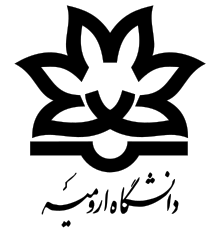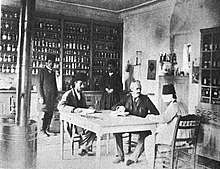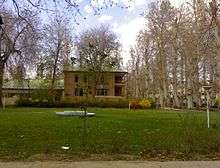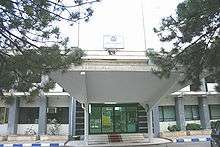Urmia University
Urmia University (Persian: دانشگاه ارومیه; Azerbaijani: اورمو بیلیم یوردو) (also known as the University of Urmia) is a public university in West Azarbaijan province, Iran. The main campus of Urmia University is in Nazlu, in the vicinity of Urmia. It has six campuses, seven schools, more than 14,000 students, and several exclusive research centers including Microelectronic, Antenna and Microwave Laboratory, Nanotechnology, MEMS, and Artemia. Urmia University also has two satellite campuses in Khoy and Miyandoab city. Nazlu campus of Urmia University is the biggest university campus in size in the northwest of Iran. Urmia University is ranked as one of Iran's "Grade A" universities by Ministry of Science, Research and Technology.
دانشگاه اروميه | |
 | |
| Latin: Universitas Urmiensis | |
| Type | Public |
|---|---|
| Established | 1878-1905 & 1965-present |
| President | Rahim Hobbenaghi |
Academic staff | ~572 |
Administrative staff | ~637 |
| Students | 15,000 |
| Undergraduates | 14,000 |
| Postgraduates | up to 1,000 |
| Location | , West Azarbaijan Province , 37°39′24.82″N 44°59′12.42″E |
| Campus | Urban & Suburban |
| Athletics | several teams |
| Colors | turquoise and white ; |
| Website | www |
History
Westminster Medical College (1878-1905)


Urmia University is founded in place of Westminster Medical College, which was founded by Joseph Cochran in 1878 in the city of Urmia. Westminster College is considered as the first attempt to establish a higher education institution in Urmia. Dr. Cochran, an American citizen who was born in Urmia, spent his entire professional life in developing the medical college and hospital in Urmia.[1]
The website of Urmia University credits attempts of Cochran for "lowering the infant mortality rate in the region" and for founding one of Iran's first modern hospitals (Westminster Hospital) in Urmia. The medical faculty Cochran established was joined by several other American medical doctors including Dr. Wright, Dr. Homlz, Dr. Van Nourdon, and Dr. Miller. They lived their entire life in Urmia.
The certificates of the graduates from Westminster Medical College were jointly signed by Dr. Cochran and King Mozaffar-edin Shah. This college continued to educate students in medical science until the death of Dr. Cochran in 1905. The office of Dr. Cochran and his medical college in the wooden building are preserved in the city campus of Urmia University. The university website honored Cochran and his team's work saying:
There they lie in peace away from their homeland and the testimonial epitaphs on their tombs signify their endeavor and devotion to humanity.
Later re-establishment and developments (1965-)
The formal foundation for current Urmia University was laid in 1965 when the Agricultural College of Rezaeiye was established. Mr. Shabani was appointed as the first consular of the newly established college. In 1969, Jafar Rassi was appointed as chancellor to continue the expansion of the University. In 1970, the Iranian Ministry of Science assigned further development of the college to the university. An agreement was signed between the Iranian government and the Near East Foundation in the United States to establish a four-year program. Later, Dr. Rassi was appointed as the new consular of the college. Dr. Rassi, the longest-serving consular of Urmia University till date, established the Animal Science and Science Departments. Under his leadership, the college started a four-year program of bachelor's degree. He also established a partnership with European and American schools to establish an exchange of scholars. He planned the expansion in Nazlu Campus which is now the primary location for the University. With the new developments, the complex was renamed as the University of Rezaeye in 1977. After the Iranian Revolution of 1979, the name of the university was changed to Urmia University. In 1980, the faculty of Medical Science was established. As part of the Iranian Ministry of Health, Urmia University of Medical Sciences detached itself from the main school in 1985. The Faculty of Humanitarian Science was established in 1989 and Faculty of Engineering was established in 1990.[2][3]
Campuses

Urmia University has six campuses, all of which are located in West Azarbaijan Provence. The main campus is located in Nazlu on the 11 kilometres (6.8 mi) road from Urmia to Serow. Here is a list of all campuses:
- Nazlu Campus, the main campus, in Nazlu village.
- City Campus in Urmia city.
- Literature Campus inside Urmia city.
- School of Economics Campus 1.5 kilometres (0.93 mi) of Serow Rd.
- School of Arts Campus inside Urmia city.
- Khoy Campus
Buildings


One of the famous buildings of Urmia University is the Wooden Building, the oldest building in the city campus. In the present day, most of the major buildings of Urmia University are in Nazlu campus:
- Central library
- School of Science
- School of Engineering
- School of Agriculture
- School of Medical Science
- Department of Natural Resources
- Department of Paramedical Science
- Animal Science Department
- Veterinary Science Building
- Classroom Building
- Enrollment office building
- Azadegan Gymnasium
- Chamran Auditorium
- Mosque
- Technology Park
- Central Restaurant
- North campus (boys' residence)
- South campus (girls' residence)
Schools
Urmia University consists of eleven schools including:
School of Engineering
The School of Engineering at Urmia University initiated its work as a technical school providing associate-degree (A.S.) programs in the fields of Electronics and Civil Engineering. The major aim of founding this school was to promote science and technology in different engineering trends and offer technical services for industries at the provincial scale. After recruiting experienced and qualified faculty members, in 1988, the school officials admitted BS students in Civil Engineering and Electronics. The school was promoted into the Faculty of Engineering after establishing the field of Mechanical Heat and Fluid in 1991.[4]
- Department of Mechanical engineering
- Department of Electrical engineering
- Department of Civil engineering
- Department of Surveying
- Department of Mining
- Department of Chemical Engineering
- Department of Architecture
- Department of Industrial Engineering
School of Electrical Engineering (ECE)
Masters and Ph.D. programs in Electronics were launched in 1995 and 1997, respectively. The ECE extended its activities with admitting students in Master of Telecommunication in 2001, Ph.D. in Telecommunication in 2012, Master of Electronics with Micro-Nano Electronics System strand in 2013, and Ph.D. in Electronics-Power in 2014. The Department of Computer Software Engineering joined other departments in 2002 and initiated its activities in higher education with providing MS programs in Computer Networks and Ph.D. in Computer Networks in 2009 and 2012, respectively. The major objective of the undergraduate program is to raise students’ academic standards and qualify them so that they end up taking positions in the academia, industry, and government. The graduate program of ECE emphasizes integrated circuit design in a wide variety of subjects. Graduates of ECE collaborate with their professors to conduct research projects and turn the department to one of the leading electrical engineering departments in Iran. The graduate program offers Master of Science and Ph.D. degrees. The graduate program is run jointly with the collaboration of Micro-electronics Research Center & Urmia MEMS Center. The research projects involve the investigation of a broad spectrum of theoretical and real-world problems. Some of ECE's main research areas are listed below: Analog Integrated Circuits, Digital Integrated Circuits, VLSI, Data Converters, RF, Image sensors, Learning, Pattern Recognition and neural networks, MEMS and Micromachining.[4][5]
- Department of Computer Engineering
- Department of Electronics Engineering
- Department of Telecommunications Engineering
- Department of Electrical Power Engineering
School of Sciences
The Faculty of Science began its activity in 1979 with accepting students in two fields of physics education and plant sciences. It is situated in Nazlou Campus and is one of the important educational and research centers of Urmia University.[6]
- Department of Physics
- Department of Mathematics
- Department of Geology
- Department of Biology
- Department of Statistics
- Department of Environmental science
School of Chemistry
The Faculty of Chemistry was founded in 2017 and began its formal functioning together with two major departments. M.Sc. Chemistry courses have been held in Organic and Inorganic Chemistry department since October 1997 and admitted Ph.D. students in Organic Chemistry since February 2003.[7]
- Department of Analytical Chemistry and Applied Chemistry
- Department of Organic and Inorganic Chemistry
School of Humanities, Science and Literature
The Faculty of Literature and Humanities was founded in 1988 with the establishment of the Department of Persian Language & Literature in an area of 1378 square meters in one of the best regions in Urmia.[8]
- Department of Islamic History
- Department of Geography
- Department of Philosophy
- Department of Physical Education & Sport Sciences
- Department of English literature
- Department of Persian literature
- Department of Turkish literature
- Department of Islamic Mysticism
- Department of Psychology
- Department of Painting
School of Agriculture
The Faculty of Agriculture is one of the oldest schools of Urmia University. In 1968, with the approval of the Board of Trustees of the College of Agriculture, the College, the University of Tehran was independent. In 1969, an agreement between the names of the Near East Foundation and the Ministry of Culture to increase the period of time of two years signed a four-year program's Dean J. Rassi Grftnd.dr 1969 with the creation of the field of animal husbandry, the Faculty of Agriculture and Animal Husbandry Urmia renamed. Given that the School of Veterinary Medicine in 1975 and in 1977 the Faculty of Science and Faculty of Medicine and Nursing were added.[9]
- Department of Agricultural Extension & Education
- Department of Agronomy & Plant Breeding
- Department of Animal Sciences
- Department of Food Industry
- Department of Horticulture
- Department of Irrigation
- Department of Plant Protection
- Department of Soil Sciences
School of Economics and Management
The Faculty of Economics and Management was established in 2007 as an educational and research center. It aims to produce, transfer, and expand knowledge in the realm of economics and train human resources who are experts in the fields of economics, financial accounting, and management.[10]
- Department of Economics
- Department of Management
- Department of Accountancy
Faculty of Veterinary Science
The Faculty of Veterinary Medicine was established in 1975. Currently, this long-established faculty enjoys the cooperation of 56 Academic members (15 Professors, 19 Associate Professors, and 22 Assistant Professors), 10 lab technicians, and 31 employees. It accepts Iranian as well as international students in Doctor of Veterinary Medicine, DVSc/Ph.D., and Master of Science (MSc) programs.
- Department of Basic Sciences
- Department of Food Hygiene and Quality Control
- Department of Internal Medicine and Clinical Pathology
- Department of Microbiology
- Department of Theriogenology and Poultry
- Department of Pathobiology
- Department of Surgery and Diagnostic Imaging
Faculty of Architecture, Urban Development & Art
The Faculty of Arts began its activities in 2002 by admitting 25 students in the field of Urban Engineering, which was within the Faculty of Engineering. In 2004, with the approval of honorable authorities and former minister of Housing and Urban Development, Hedayat School Building which is of historical significance was awarded to Urmia University in order to establish the faculty. The Faculty of Arts was established in this historical building and started running two undergraduate programs, namely Architecture and Urban Engineering.
- Department of Architecture
- Department of Painting
- Department Restoration of Monument
- Department of Urban Development
School of Natural Resources
After gaining approval in 1997, the Faculty of Natural Resources was founded in 2002 at Urmia University with the dedicated efforts of well-informed, committed, and compassionate staff. Since then, the undergraduate program has been offered in Natural Resources Engineering Rangeland and Watershed Management.
School of Sport Sciences
The establishment of Physical Education and Sport Sciences Department at Urmia University dates back to 1990 when it began offering an undergraduate program. Since 2003, it has admitted several faculty members and postgraduate students in the management of sports organizations, motor learning, and exercise physiology which has turned the department to be one of the most vibrant physical education departments in Iran. In 2010, efforts put by the faculty members and university authorities accelerated the activities carried out by the Faculty of Physical Education and Sport Sciences. In 2011, the faculty was transferred to Nazlu Campus.
- Department of Exercise Physiology and Corrective Exercises
- Department of Sport Management
Research centers
- Artemia & Aquatic Animals Research Center (in English)Research activities related to Artemia and the ecosystem of Lake Urmia at Urmia University began with the establishment of the Artemia Research Laboratory in 1373 and then promoted to the Artemia and Aquatic Research Center by Dr. Nasir Agh. The firm support of Urmia University officials and the day-to-day activities of the Center's founder made it the reference center for Artemia in Iran and the entire Middle East and Central Asia region. With the development of the Center's research activities in various fields and the establishment of new research groups in 2004, the research center was promoted to the Artemia and Aquaculture Research Institute.
- MicroElectronics Research Center (MRC) In 1996, a research group in the field of microelectronics was formed under the direction of Dr. Kh. A. Hadidi at Urmia University. In 2000, the research group received the license under the title of "Microelectronics Research Center" from the Ministry of Science, Research and Technology. In 2004, the center was upgraded to the Microelectronics Research Institute. For seven years, the institute has also won the title of Best and Only Institute of Microelectronics in Iran.
- Urmia MEMS Center (UMC) The center was established in 2004 with the investment of Iran's Industrial Development and Renovation Organization under the direction of Dr. E. Abbaspour. UMC is one of the most advanced technology projects in the country which has been built in an area of 10,000 square meters and with an infrastructure of 2,200 square meters at the city campus of Urmia University, in which the facilities and equipment of a semi-industrial clean room are located.
- Biological Sciences Research Center The Biomedical Research Center of Urmia University was established in 2000 with the approval of the Ministry of Science, Research and Technology. Currently, the Institute continues its work in four areas: agricultural biotechnology, cellular and molecular biotechnology, biotechnology, and biotechnology of pharmaceutical and industrial plants.
- Urmia Lake Research Institute (ULRI) Established in 1998 as part of Artemia and Aquatic Animals Research Institute, it has been upgraded to Urmia Lake Research Institute (ULRI) in 2013. The institute currently has 4 departments, 20 scientific staff and 5 laboratories with sophisticated equipment. ULRI was involved in many national and regional projects on Urmia Lake.
- Nanotechnology Center Since the beginning of fall semester in 2010, the nanotechnology institute of Urmia commenced the initial academic activities with taking MSc. students in nano-chemistry as well as nano-physics degrees. The nanotechnology institute of Urmia has taken modern laboratories comprising organic chemistry, thermo-analysis, electrochemistry, and nano-electronic as well as nano-composite.
- Computer Emergency Response Team The Urmia University Computer Emergency Response Team (CSIRT) has been set up to provide information, support, and relief, and focus on the Internet security of objects. The CSIRT of Urmia University, the only Internet security center in the province was established in April 2016.
Presidents
| President | Tenure | Alma mater | Speciality |
|---|---|---|---|
| Joseph Cochran | 1878-1899 | Medicine | |
| Shabani | 1965-1969 | ||
| Jafar Rassi | 1969-1979 | Education | |
| Javad Farhoudi | 1980-1982 | Hydraulic Structures Engineering | |
| Ali Sarafraz Yazdi | 1983-1986 | Chemistry | |
| Seyyed Mehdi Razavi Rouhani | 1986 - 1996 | Veterinary Science | |
| Rahim Hobbenaghi | 1997-2001 | Veterinary Science | |
| Goudarz Sadeghi-Hashjin | 2001-2005 | Pharmacology | |
| Hassan Sedghi | 2006-2014 | Solid State Physics | |
| Rahim Hobbenaghi | 2014–present | Veterinary Science | |
Notable alumni
- Isa Kalantari, former Minister of Agriculture and Vice President of Iran in environmental affairs.
- Mohammad Oraz, first Iranian national to successfully climb Mount Everest.
References
- See Cochran's biography on the Iranian Academy of Medical Sciences website
- http://www.daneshjoonews.com/archives/5505
- "About Urmia University" Official page in Persian Archived 2008-07-01 at the Wayback Machine
- "| Urmia University". en.urmia.ac.ir. Retrieved 30 December 2018.
- "| Urmia University". en.urmia.ac.ir. Retrieved 30 December 2018.
- "| Urmia University". en.urmia.ac.ir. Retrieved 30 December 2018.
- "| Urmia University". en.urmia.ac.ir. Retrieved 30 December 2018.
- "| Urmia University". en.urmia.ac.ir. Retrieved 30 December 2018.
- "| Urmia University". en.urmia.ac.ir. Retrieved 30 December 2018.
- "| Urmia University". en.urmia.ac.ir. Retrieved 30 December 2018.